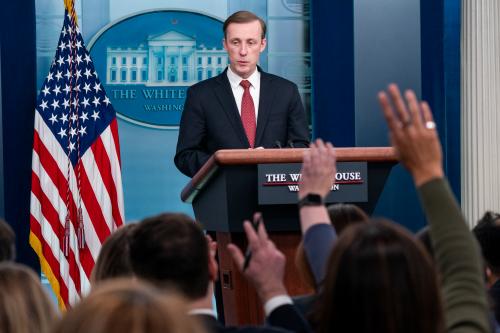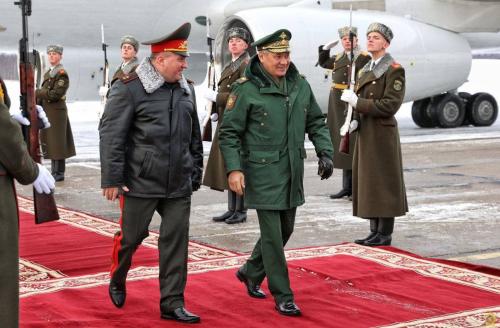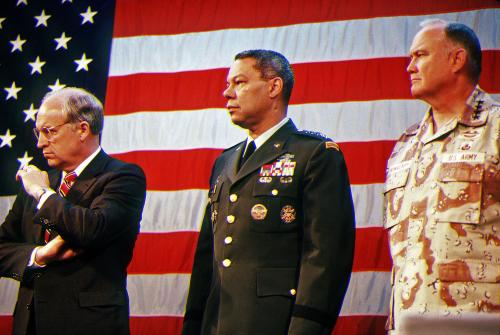Content from the Brookings Doha Center is now archived. In September 2021, after 14 years of impactful partnership, Brookings and the Brookings Doha Center announced that they were ending their affiliation. The Brookings Doha Center is now the Middle East Council on Global Affairs, a separate public policy institution based in Qatar.
The Syrian conflict is now in its fourth year. With time, the strategic momentum has shifted back towards the regime and today we have reached near-total stalemate. For this, President Assad can thank Russia, Iran and other sub-state supporters for their unwavering support. Meanwhile, the opposition has been steadily weakened by a comparatively unpredictable and divided support structure, composed of the U.S., EU and regional states, and countless shadowy Gulf-based private finance networks. In such dynamics, the Syrian Coalition failed to win any practical results at Geneva II, thereby underlining and further bolstering government confidence in Damascus.
Since then, significant attention has been paid to the viability of an expanded and enhanced U.S. assistance program to vetted elements of the armed opposition. Recent indications citing Obama administration officials have suggested that existing small-scale covert CIA-led training of pre-approved moderate rebels will be expanded. Reports have said this new program will be founded on counter-terrorism principals, aimed at isolating and combating jihadists linked to Al-Qaeda as well as securing borders and facilitating more impactful humanitarian assistance.
Importantly, it seems likely that recent leaks on this subject have primarily been related to supporting President Obama’s visit to Saudi Arabia. Will this expanded program even take place? After all, many similar indications have been given in the past with no subsequent discernible change. Nonetheless, much of the leaked details raise worrying questions regarding whether the multilayered complexity on the ground in Syria is being taken into account. As has been said before, the Syrian insurgency is not as simple as ‘good guys’ and ‘bad guys.’
It has been clear for several months that a fundamental principle guiding existing U.S.-linked support to Syria’s armed opposition is based on countering the growing number of Al-Qaeda and other similarly aligned militants – now totaling at least 20,000-25,000. There is no doubt this should be a serious concern, but it will not be a simple task and it should not be rushed into. Al-Qaeda’s Syrian affiliate, Jabhat al-Nusra, enjoys remarkable levels of popular support across Syria’s anti-government population. Even many key members of the Western-backed Coalition have refused to condemn Jabhat al-Nusra, which manages countless inter-dependent relationships with localized moderate rebel groups across the country, including with members of the now widely celebrated Syrian Revolutionaries Front, led by Jamal Maarouf. In fact, Maarouf himself claimed in a recent interview that Al-Qaeda – or Jabhat al-Nusra – is “not our problem” and openly admitted cooperating with that organization inside Syria.
So where does the line of acceptability lie? If it means any group who has fought with Al-Qaeda, then a large proportion of rebels are to be immediately discounted. If it means any group who has fought with individuals or groups linked to Al-Qaeda, then you are left with very little indeed.
An all or nothing policy aimed at directing vetted groups to confront or isolate all jihadist-minded groups will prove a self-fulfilling prophecy, turning those groups into the anti-Western forces we most fear. While the Islamic State in Iraq and al-Sham, or ISIS – whose actions in Syria were so extreme that Al-Qaeda disavowed it – has been effectively isolated, the conditions for replicating this upon other jihadist groups do not exist — yet. Truly hostile jihadist organizations tend to eventually foster the conditions necessary for their eventual isolation and demise. Rather than create new enemies, current policy should focus on bolstering the capacity of our friends and if possible, seeking and training more recruits for their cause.
Openly available estimates suggest the existing CIA-led training program, based primarily out of Jordan – but also allegedly Saudi Arabia, Turkey, and Qatar – produces approximately 100 fighters per month. If recent leaks are to be believed, this number could reach 600 per month. At this rate, it would take close to two years to produce a force numerically rivaling the largest armed group in Syria, Ahrar al-Sham, and it would take seven years to rival the Islamic Front.
Regarding weapons provision, the integration of tracking and remote shutdown mechanisms would be valuable fail-safes, but no technology is perfect. While such measures may prevent the sharing of man-portable air-defense systems, or MANPADS – which, despite reports to the contrary, the U.S. will almost certainly never consider supplying – the proliferation of lighter weapons is inevitable. Bear in mind that some Croatian weapons provided to the Free Syrian Army in early-2013 rapidly ended up in the hands of Jabhat al-Nusra, while others are now in Iraq being used by ISIS.
Despite all of this, the U.S. and its allies must expand their support to Syria’s opposition. But in so doing, the inherent complexity of the situation needs to be grasped and not simply brushed over. Today’s immediate policy priority should be focused on healing deeply damaging divisions within the opposition Coalition and its various supporters. Then, existing opposition bodies need restructuring to better incorporate impactful actors inside Syria. At this point, some of the deeply engrained complexity will have become manageable, allowing more reliable and sustainable opportunities to present themselves for developing a more effective military support program inside Syria.



Commentary
Op-edIncreasing Military Assistance to the Syrian Opposition? Some Ground Truths…
April 3, 2014